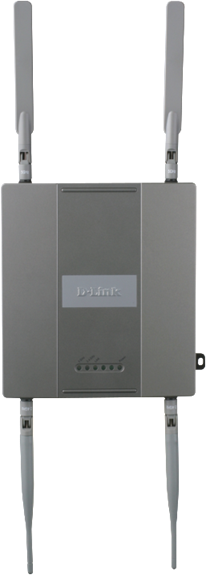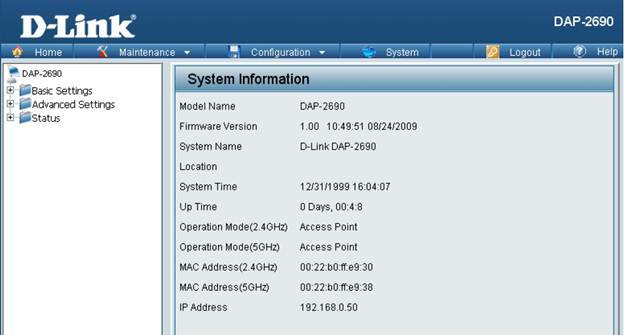There are many solutions for home and small office home office (SOHO), but there are few products that can serve the large enterprises with expansive wireless networks. DAP-2690 is one of the few products built to address this market segment. It is a wireless n simultaneous dual band access point with Power over Ethernet (PoE) support.
Wireless specifications: The device being a dual band wireless access point, it can operate in 2.4 GHz and 5 GHz range. In the 2.4 GHz range, it can support the wireless g and n standards while in 5 GHz it supports wireless a and n standards. It can support speeds as high as 300Mbps in both the frequency bands over the wireless n standard. With wireless ‘a’ and ‘g’ standards the maximum speed that can be achieved is around 54Mbps. It has three detachable antennas that can be attached and their orientation adjusted to enhance the overall coverage in the area. The antennas also provide spatial diversity that enhances the robustness of the wireless network to interference.
The device supports Power over Ethernet or 802.3af standard that allows it to draw power from the CAT5 or Ethernet cable directly. This is invaluable in enterprise deployments. The biggest advantage of this support is that installing an access point requires just a single CAT5 cable rather than a CAT5 and a power supply. This reduces need for extra cabling thereby simplifying the network design and installation.
The device also supports Wireless Multimedia (WMM) that allows prioritising traffic. With WMM, the device is able to ensure that voice and video traffic get higher priority over data. This allows for enhanced end user experience over the wireless network.
Wireless Security: DAP-2690 AirPremier N simultaneous dual band PoE access point has several enterprise grade security features ideal for the mass scale deployment in large organisations. It supports personal and enterprise versions of Wi-Fi Protected Access (WPA and WPA2) with 802.11i and RADUIS Server. With the enterprise RADUIS server compatibility, the wireless devices that need to connect the network first get authenticated by the server and then gain entry into the network.
The device also supports up to 16 VLANs and multiple SSIDs to keep different set of users segregated. This way different set of users do not end up sharing the same network or gain access to each other’s information. The device also supports device isolation ensuring that individual devices cannot setup a point to point connection with each other directly without going through the network.
Wireless Operating Modes: The device supports four operating modes: Access Point (AP), Wireless Distribution System (WDS), WDS with AP and wireless client.
| Operating Mode | Description |
| Access Point | In this mode the device acts as a hub that connects multiple wireless devices to the network. |
| WDS | In this mode the device acts as a bridge connecting different wired LAN segments. |
| WDS with AP | In this mode, it acts as a bridge for wired LAN segments as well as the hub for wireless devices. |
| Wireless Client | In this mode, the DAP-2690 acts as a wireless medium for connecting the Ethernet based devices to the network |
Device Management: The DAP-2690 supports multiple management options like: web browser, AP manager II and SNMP. The web browser is the most basic and common way to configure the device. It is a well-known option for network administrators and users to setup the device and the network. The AP manager II is a customised solution developed by D-Link to manage the DAP-2690 and similar solutions. This is a great way to manage the devices, as long as the entire enterprise network is comprised of devices supported by the product. If the enterprise has its own network management system, the DAP-2690 can also be incorporated into that using the SNMP MIBs giving more flexibility and accessibility to manage the device.
Configuring Access Points: The access point comes with default settings of DHCP client disabled and an IP address of 192.168.0.50. To configure the access point, one needs a computer that is configured in the same subnet as the access point. This is mandatory for the initial configuration. Once the IP address of the access point is changed to an address in the enterprise network or once the DHCP client is enabled, it can be accessed and configured remotely using SNMP Network management system or any other option. The username for the web browser access is admin and the password is blank.


